
This is the Hot Wheels 2013 Max Steel Motorcycle #59/250 in white. What is Max Steel you ask? Well I tried to read the Wikipedia article and that didn't help me much. Basically, it's a Mattel story developed to sell toys. This was illegal once.

This is the Hot Wheels 2013 Max Steel Motorcycle #59/250 in white. What is Max Steel you ask? Well I tried to read the Wikipedia article and that didn't help me much. Basically, it's a Mattel story developed to sell toys. This was illegal once.

These were found on top of a gas pump in Michigan.
2013-08-16
13 cents
Total: $0.13
2013 Cumulative
$9.63
Overall Cumulative:
$11.06 Loose Change
3200 MS Points
$230 Amazon Gift Cards
Grand Total:
$281.39

This is a picture of a june bug.
Model – Canon EOS REBEL T3i
ExposureTime – 1/100 seconds
FNumber – 32
ISOSpeedRatings – 320
FocalLength – 250 mm
Flash mode – External flash

2013-08-12
1 nickel
Total: $0.05
2013 Cumulative
$9.50
Overall Cumulative:
$10.93 Loose Change
3200 MS Points
$230 Amazon Gift Cards
Grand Total:
$281.26

2013-08-10
1 dime
Total: $0.10
2013 Cumulative
$9.45
Overall Cumulative:
$10.88 Loose Change
3200 MS Points
$230 Amazon Gift Cards
Grand Total:
$281.21

If you haven’t already, please see the preceding articles:
DIY Trading Cards, Part 1
DIY Trading Cards, Part 2: Making it Physical
DIY Trading Cards, Part 3: Specialty Cards
A puzzle card is a pretty simple to make. Instead of designing one card at a time, design as a set of 9.
Choose a design that can be cropped/resized to 2250 x 3150. Place that picture onto the 9 card layout sheet and you’ve made the front of the card.
For the back you can either use another 2250 x 3150 picture or make them individual designs for each card. Place these in the desired order on another layout sheet. If you choose to number the cards, remember you are looking at the back, right to left, top to bottom.

If you haven’t already, please see the preceding articles:
DIY Trading Cards, Part 1
DIY Trading Cards, Part 2: Making it Physical
DIY Trading Cards, Part 3: Specialty Cards
If you haven’t collected cards in the past 20 or so years you wouldn’t know about this new trend of Memorabilia cards. Typically the idea is to include a piece of jersey into the confines of a 2.5″ x 3.5″ card. With a couple extra steps it’s possible to make your very own memorabilia card.
There are three layers to the card, four if you want to use a thicker material. The outer two layers are the same as always, a front and back of the card. In addition, since you’ll be cutting a hole in the top sheet, I use magazine backerboards for stability. If it’s going to be a thicker material also use something like Canson Art Board, 180 gsm depending on how thick you need to go.
Design your card the same as normal. On the front design I draw a box the size and shape that I want the window to be. An inch and a half seems like a pretty good size to use so I design in that. I bought a Fiskars 1.5″ Punch to make consistent windows.
Cut the window in the front sheet.

For this set I cut my fabric/paper to 1.75″ x 1.75″ to have a little overlap on the window. This allowed me to glue them all down with some Super Glue Gel. Definitely use Gel, you really don’t want it to run and end up gluing the sheet down to your table. This leaves you with a slightly wedged card, really only noticeable when you stack a few together.
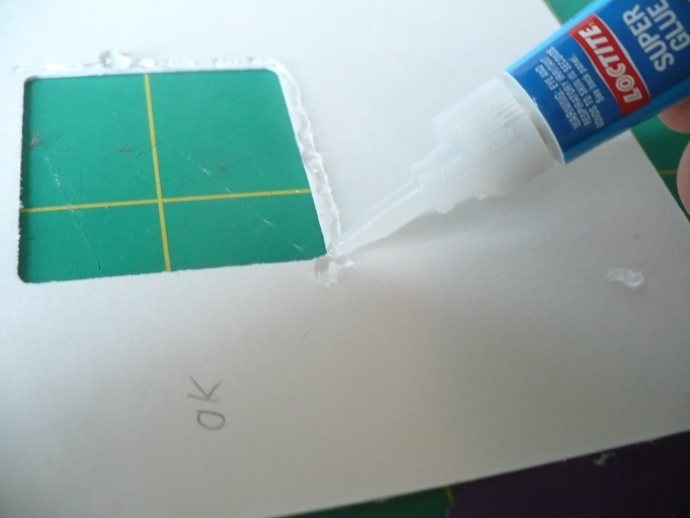
Be careful when you place the fabric/paper and/or window that you are not too close to the edge you will be cutting later. I’ve made that mistake and ruined a few cards. They won’t stay together well if it’s exposed. Because of this you might be better off cutting the fabric/paper small enough to fit in the window you created.
If you’re going to use something thicker, first glue the front sheet to the art board.
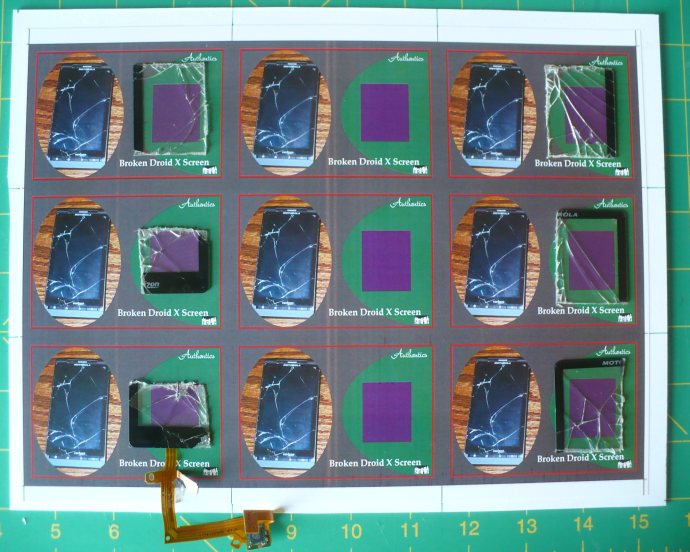
Use a sharp knife to cut out the shape, after tracing if necessary.

Again, attach the backer board to the back sheet and combine with the front sheet. Then, glue liberally with either the gel super glue or 3M Maximum Strength Adhesive depending on your needs, place the memorabilia into the window and hold firmly for a good set. Apply the backer board to the back sheet and glue the two sides together. After the glue is dry, cut and you’ve made your very own memorabilia card! You can individually number them for a little extra pizzazz.

If you haven’t already, please see the preceding articles:
DIY Trading Cards, Part 1
DIY Trading Cards, Part 2: Making it Physical
DIY Trading Cards, Part 3: Specialty Cards
Now that you have mastered the art of making a standard card, you are ready to add some flair. One of my favorite parts of opening a pack of cards is finding a neat chase card like a hologram.
A hologram card is a total of four layers: front, back, hologram and paint.
You might have never thought about this, but your printer doesn’t print white. It uses the white of the paper to make any shade that needs it. To make the hologram cards, we are going to use transparency paper, pretty much any kind that works with your printer will do. I used this Laser Transparency Film.
There are lots of choices for hologram. Hobby Lobby seems to have the best (only?) selection of 12 in X 12 in hologram sheets. If you check often they go on sale for 50% off. At $0.99 a page, that is one of the best prices I’ve found. Also check out Dollar Tree; the one near me has hologram gift bags which are good for two sheets each. This is what I am using in the example. I also purchased a roll of gold wrapping paper that works well.
In order to get the proper colors and to keep the hologram from showing through your image, you will want to paint the back of your image. I use a combination of Acrylic Paint
and a White Marker.
Remember, you want to paint on the back so that it reads correctly when you’re done.
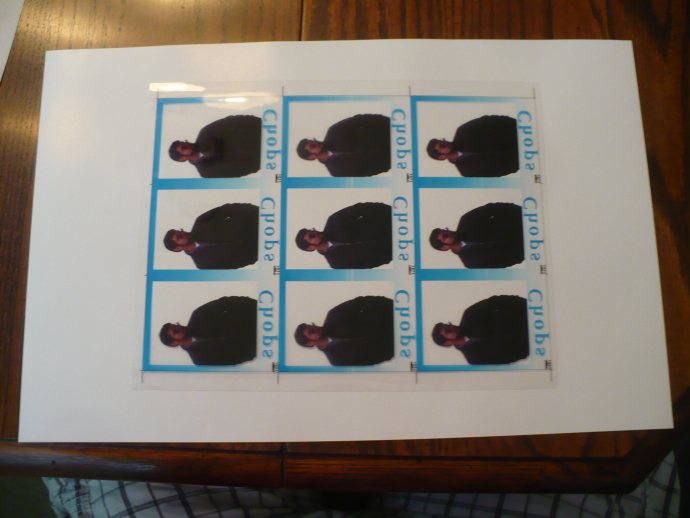
I start by taping off along the edges so I can get a crisp line.

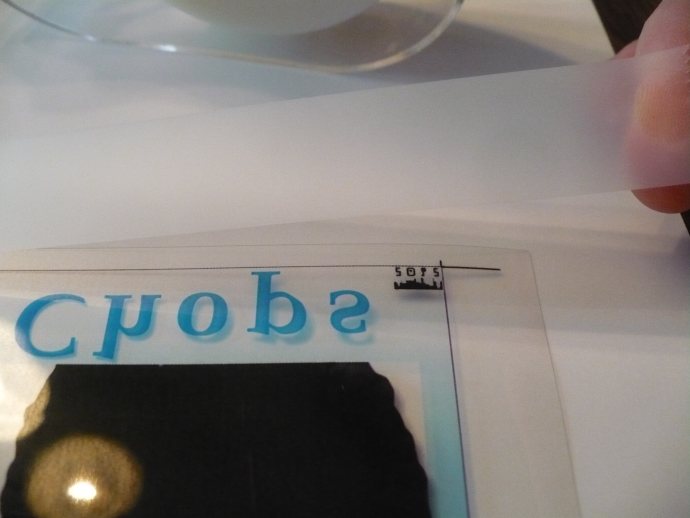
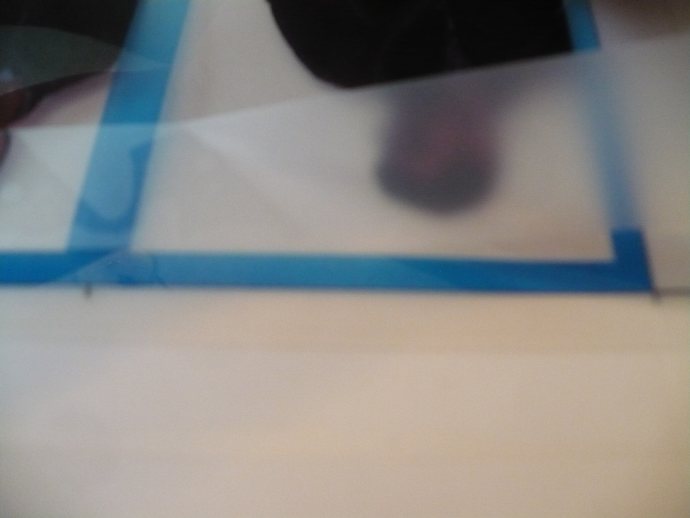
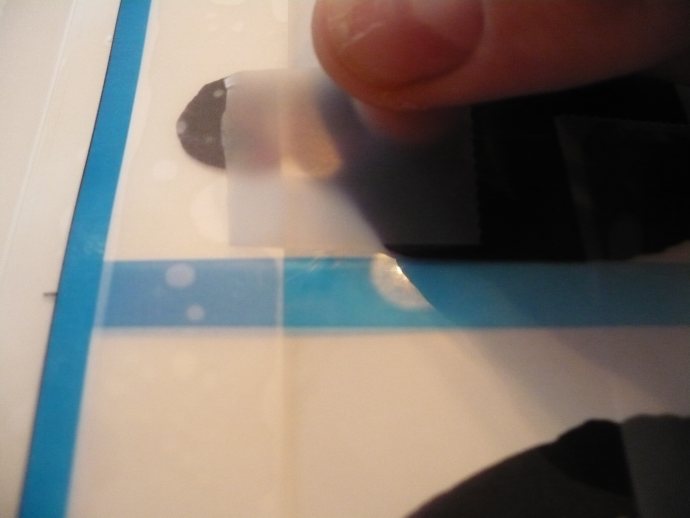
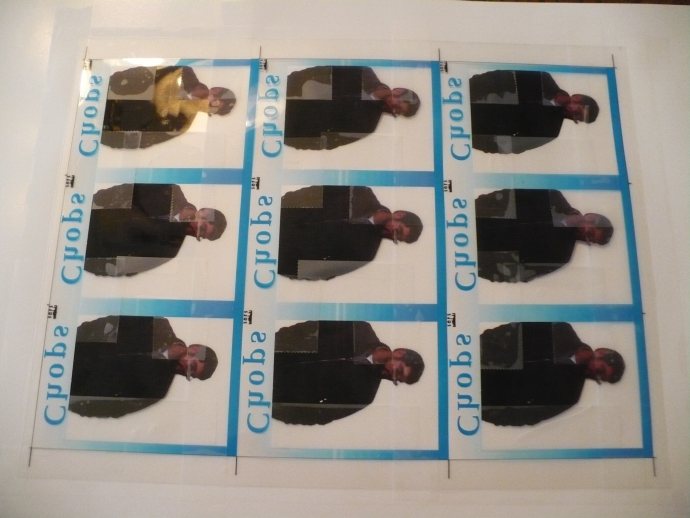
It is at this point that I take out my paint and go to town. Two coats here is not a bad idea. The darker your colors, the less you really need to apply the paint. Conversely, the lighter it is, the better job you should do.

After you peel all the tape off, you can fill in with your paint pen.

A couple coats here is good too. You want to make sure that you have enough.
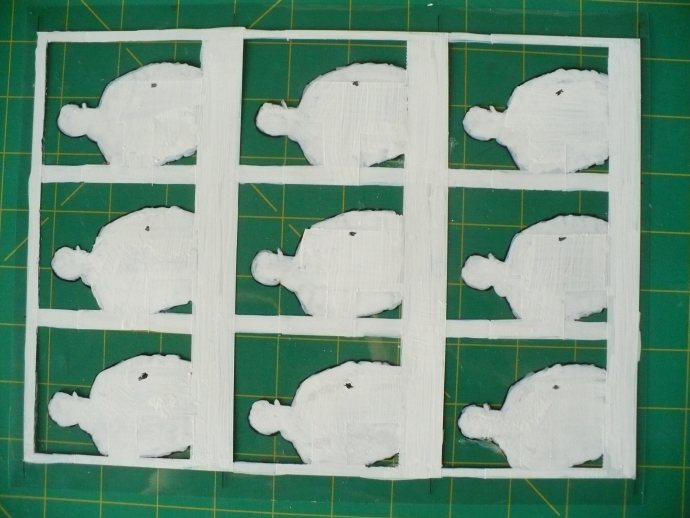
Once you are done, turn it over on any non-white surface. You want to see where you painted outside the lines. You can use an exacto knife or similar to scratch off unwanted paint. Once you are done, line up the front and back sheets as before and staple.
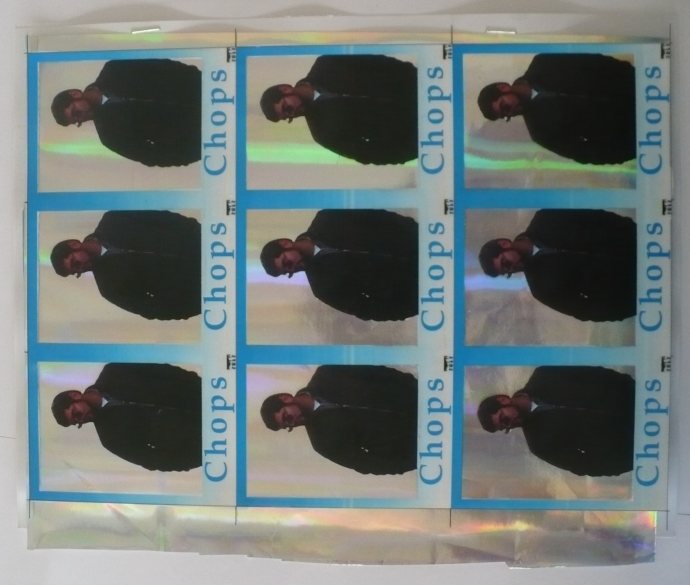
Place your hologram sheet in between and glue it all together. Make sure to press down where it’s still transparent. The paint is going to keep the transparency just a little bit away from the hologram paper, and you want the glue to make a good hold. After the glue has set, cut as before. Since this is a little thicker, apply extra pressure to the sheets to keep them from slipping while running the blade.
If you haven't already, please see the preceding articles on making trading cards at home:
DIY Trading Cards, Part 1
DIY Trading Cards, Part 2: Making it Physical
Now that you have mastered the art of making a standard card, you are ready to add some flair. I created some specialty cards, and here are my howtos:
DIY Trading Cards, Part 3a: Hologram Cards
DIY Trading Cards, Part 3b: Memorabilia Cards
DIY Trading Cards, Part 3c: Puzzle Cards
Next up: DIY Trading Cards, Part 4: Packs

2013-08-08
1 cent
Total: $0.01
2013 Cumulative
$9.35
Overall Cumulative:
$10.78 Loose Change
3200 MS Points
$230 Amazon Gift Cards
Grand Total:
$281.11